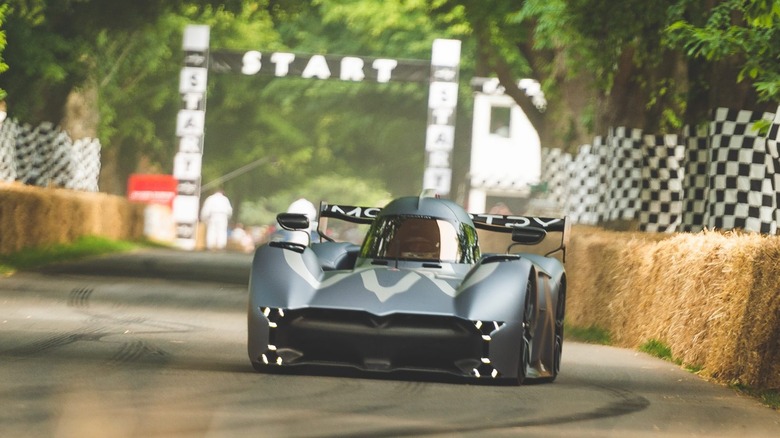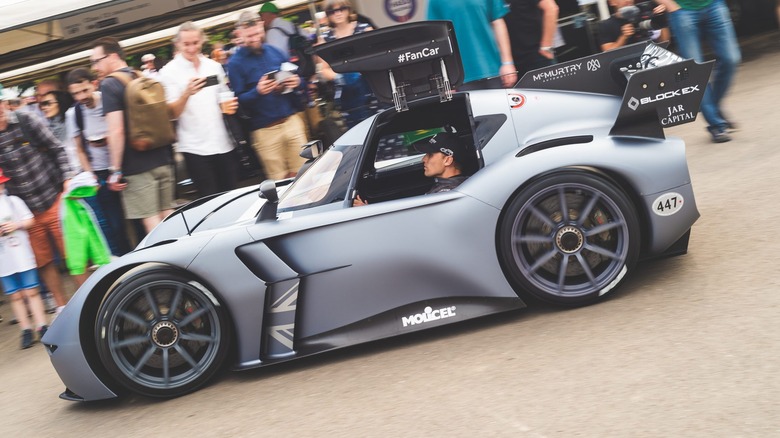This Bizarre Fan Powered Electric Car Just Set An Unbelievable New Record
The Goodwood Festival of Speed's 23-year-old outright hill record has finally been broken — and the car that did it isn't what many would consider conventional. The McMurtry Spéirling, driven by former Formula 1 driver Max Chilton, actually managed to break two records with its lightning-quick time of 39.08 seconds on Sunday. Both the official record time of 41.6 seconds and the unofficial record of 39.9 seconds were smashed during the Sunday Shootout (via McMurtry).
After setting the record, Chilton — who is McMurtry's current lead development driver — said: "I've been coming to Goodwood since I was 4 years of age. After witnessing the Nick Heidfeld official record: Did I ever think I would be the one to beat that? No. Taking this record is the most memorable of my racing career. This was only possible due to the amazing team of engineers at McMurtry Automotive. Thank you to the Duke and Duchess and for all the fans for their support"
Goodwood's famous hillclimb winds through a 1.16-mile course and can be seen as the highlight of one of the most important festivals on the automotive calendar. Supercars, Formula 1 cars, drift cars, and bikes all take on the course, with the driver posting the fastest time crowned the event's champion. The previous record was set by German driver Nick Heidfeld in 1999. Heitfield blasted through the course in 41.6 seconds while driving a McLaren MP4/13 F1. However, that wasn't the fastest time recorded on the Sunday Shootout course, just the fastest recorded during the event itself. In 2019, former Le Mans winner Roman Dumas beat Heirfield's time after posting 39.9 seconds in qualifying. Unfortunately for Dumas, as it wasn't during the Sunday Shootout itself, his blistering run could only go down as the unofficial record.
The McMurtry Spéirling is a very strange beast
Our new champion, the British-made McMurtry Spéirling, is a very unique car. Aside from being insanely fast even when going uphill on a very wavy stretch of tarmac, the electric vehicle comes with a number of unique features. In designing the Spéirling, McMurtry claims to take inspiration from "the legendary banned innovations of races past." The most obvious place this has happened is with the fan power system, which is based on the Brabham BT46B — a fan-powered Formula 1 car that won the Swedish Grand Prix.
The Goodwood Edition weighs just over a ton and can get from 0 to 60 mph in less than 1.5 seconds. To put that into context, the Spéirling can go from a standstill to highway speed twice as quickly as a Lamborghini Aventador LP 780-4 Ultimae, which is far from a sluggish vehicle. It can probably comfortably hit 60 mph before you can type the words McMurtry Spéirling.
We've all seen this before. A car company decides to turn its research and development budget into a bit of extra PR money by creating some freakish machine that'll never be allowed on the street. It blows everyone's minds at a festival or two by showing them what could be possible in an alternate universe without budgets or speed bumps, then spends the rest of its days in an automotive museum, sitting perfectly still and being far less impressive. Well, not the Spéirling. If you're the kind of person who has the means to get a world-beating hypercar, this mind-bending EV will be available for purchase.
There's a road-legal version of the Spéirling
While the Goodwood Edition is a prototype, the road-legal version of the Spéirling is unlikely to disappoint anyone lucky enough to get their hands on one. According to McMurtry, it will still go from a standing start to 60 in less than two seconds. If you do get your hands on one, you'll be experiencing it alone. Unlike the legendary McLaren F1, which put the driver in the middle but included a passenger seat on both sides, the Spéirling is purely a single-seater vehicle. So if you decide to take a 300-mile trip, which it can do in one charge, you'll be playing punch buggy alone.
Potentially the most impressive part of the Spéirling is also central to its roadgoing version. Giving a car ridiculous amounts of power hasn't been a problem, but transferring that power from the motor to the road is a dilemma. If the grip doesn't match the power, the car's just going to spin its wheels until the tires disintegrate. The torque produced by the Spéirling's electric powertrain goes a long way to giving it the grip it needs to get the most from its motor and stick to the road in the corners. However, the real star of the show is the car's downforce-on-demand system, which provides tons of grip by forcing the car into the ground. Although aerodynamics play a part in the move, that's why spoilers exist and cars no longer have flat fronts — the downforce-on-demand system doesn't rely on them. The system can provide more than twice the weight of the car in downforce while the Spéirling is at a standstill.

